By Mary M. Donohue
(c) Connecticut Explored Inc. WINTER 2016/2017
Subscribe/Buy the Issue!
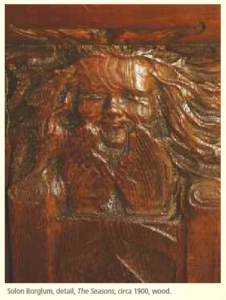 How did two brothers born on the frontier of the American West to Swedish Mormon immigrant parents—and who became renowned artists—come to have deep ties to Connecticut? John Gutzon de la Mothe Borglum (1867 – 1941) built his country home and studio in Stamford in 1910. He later became famous as the sculptor of Mount Rushmore, America’s ode to four of its presidents, carved as 60-foot-tall portraits on a mountainside in North Dakota. (See “Connecticut’s Mount Rushmore Connection,” Connecticut Explored, Spring 2015.)
How did two brothers born on the frontier of the American West to Swedish Mormon immigrant parents—and who became renowned artists—come to have deep ties to Connecticut? John Gutzon de la Mothe Borglum (1867 – 1941) built his country home and studio in Stamford in 1910. He later became famous as the sculptor of Mount Rushmore, America’s ode to four of its presidents, carved as 60-foot-tall portraits on a mountainside in North Dakota. (See “Connecticut’s Mount Rushmore Connection,” Connecticut Explored, Spring 2015.)
His younger brother, Solon Hannibal de la Mothe Borglum (1868 – 1922), moved to the Silvermine neighborhood of New Canaan in 1906 looking for a barn “large enough to accommodate his work,” as David Borglum, his grandson, told The New York Times in 2001.
Although Solon was, like his older brother, an artist, he followed his own path. His early experiences as a hand on his father’s ranch in Nebraska from 1885 to 1893 and then in California gave him first-hand exposure to horses, cowboys, and the culture of Native Americans. After studying in California and at the Cincinnati Art Academy in Ohio for two years, he went to Paris in 1897 to study sculpture at the Academie Julian. Metropolitan Museum of Art curator Shannon Vittoria notes on the museum’s website, “While abroad, he cultivated his identity as a ‘cowboy artist,’ capitalizing on the widespread popularity of the American West.” Vittoria quotes art historian Emily Burns as  observing that Borglum and others “constructed identities as rugged, virile cowboys—the new stereotypical American man popularized by Buffalo Bill Cody in Paris ….”
observing that Borglum and others “constructed identities as rugged, virile cowboys—the new stereotypical American man popularized by Buffalo Bill Cody in Paris ….”
Solon Borglum became a founding member of the Silvermine artist colony in Connecticut. From 1908 to 1922, exhibitions were held in his barn. This group of artists was first known as the Knockers Club. After Solon’s sudden death in 1922 after surgery for appendicitis, the group incorporated as the Silvermine Guild of Artists in 1924. Now the Silvermine Arts Center, it has almost 300 juried artist members.
There is another lasting Borglum connection to Connecticut. In 1974 t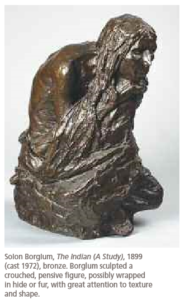 he Solon Borglum Education Fund gifted drawings, paintings, and more than a dozen bronze sculptures to the New
he Solon Borglum Education Fund gifted drawings, paintings, and more than a dozen bronze sculptures to the New
Britain Museum of American Art. This major donation forms the heart of the museum’s collection of art depicting the American West. Two newly conserved works by Solon Borglum are now on view for the first time since 1974. Cowboy at Rest (original cast circa 1904) depicts, as the museum label states, “a cowboy and his horse contemplatively gazing into the distance” and can “be viewed as a possible expression of ‘manifest destiny,’ the 19th-century belief that it was God’s will… that American settlers expand from the Atlantic to the Pacific coast.” The Seasons is a quirkier piece. It’s a carved wood fireplace mantel circa 1900. Carved faces create an allegory of summer and winter. 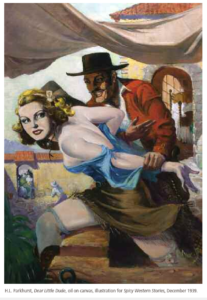 Never installed, it remained with the artist’s estate.
Never installed, it remained with the artist’s estate.
Other impressive bronzes, Sioux Indian Buffalo Dance (modeled 1902) and The Indian (A Study) (circa 1899) demonstrate the artist’s skill at portraying anatomy, a sense of tension, and his interest in historical accuracy. One in a Thousand (1901) is a dramatic vertical composition depicting a cowboy on a bucking bronco at the moment when the horse has done its utmost to throw the rider off.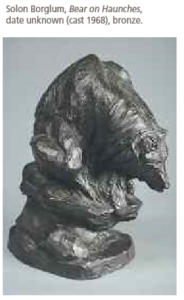
Other important works on view include Native American Portrait, a 1934 painting by Plainville, Connecticut native Alfred Hepworth, a carpenter, and, from the museum’s American pulp-art collection, a selection of magazine covers for publications illustrated here with the oil painting Dear Little Dude by H.L. Parkhurst (1867-1921), used as the cover of Spicy Western Stories in December 1939.
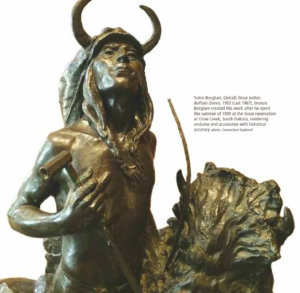

Mary M. Donohue serves as the assistant publisher of Connecticut Explored and is an architectural historian.
Explore!
New Britain Museum of American Art
56 Lexington Street, New Britain
nbmaa.org
860-229-0257
The museum’s collection includes American art from all periods; the Hyland Gallery features the arts of the American West.
All images courtesy of the New Britain Museum of American Art
